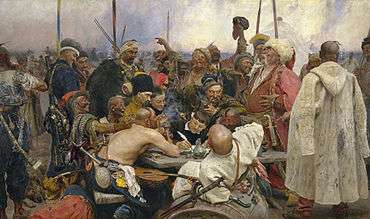Koliyivshchyna
| Koliyivshchyna rebellion | |||||||
|---|---|---|---|---|---|---|---|
Camp of Haidamakas | |||||||
| |||||||
| Belligerents | |||||||
|
| Haidamaky | ||||||
| Commanders and leaders | |||||||
|
Mikhail Krechetnikov Jan Klemens Branicki |
Maksym Zalizniak Ivan Gonta | ||||||
| Part of a series on |
| Cossacks |
|---|
 |
| Cossack hosts |
| Other groups |
| History |
| Cossacks |
| Cossack terms |
Koliyivshchyna 1768-1769 (Ukrainian: Коліївщина, from Ukr. "impaling") was a major haidamaka rebellion that broke out in Right-bank Ukraine in May 1768, caused by the social and national-religious oppression of Ukrainians by the Polish administration and nobility.[1] The uprising resulted in a mass murder of noblemen (szlachta) and other Polish population, Jews, Uniates, and Catholic priests across the part of the country west of the Dnieper river. It was simultaneous to the Confederation of Bar and a de facto civil war in Poland. The rebellion was fueled by the circulation of a fictitious proclamation of support and call to arms by Russia's Empress Catherine II. Eventually the uprising was crushed by Russian troops, aided by Polish army. Its leaders, Ivan Gonta, was tortured to death while Maksym Zalizniak was exiled to Siberia.[2]
The peasant rebellion quickly gained momentum and spread over the territory from the right bank of the Dnieper River to the river Syan. At Uman it led to a massacre of legendary proportions. Poles, Jews and Uniates were herded into their churches and synagogues and killed in cold blood. In three weeks of unbridled violence the rebels slaughtered 20,000 people, according to numerous Polish sources. The leaders of the uprising were Cossacks Maksym Zalizniak and Ivan Gonta. The latter was a Registered Cossack who changed sides and joined Zalizniak at Uman while being sent by Polish Count Franciszek Salezy Potocki to protect it. Gonta was in fact а sotnyk (i.e. a commander of a unit of 100 sabers) of the Uman Regiment.
The rebellion was suppressed by the joint forces of Polish and Russian armies, with numerous hangings, decapitations, quarterings and impalings.[3]
Casualties
According to numerous Polish sources, the total number of casualties of the Koliyivshchyna 1768 on the right-bank Ukraine is estimated at 200,000 murdered people, mainly Poles and Jews.[3]
Koliyivshchyna in popular culture
Taras Shevchenko's epic poem Haidamaky (The Haidamakas) chronicles the events of the Koliyivshchnyna. The event also inspired recent artwork during the latest Ukrainian unrest.[4]
References
- ↑ "Koliivshchyna rebellion". Internet Encyclopedia of Ukraine. Canadian Institute of Ukrainian Studies.
- ↑ "Koliivshchyna rebellion". Internet Encyclopedia of Ukraine. Canadian Institute of Ukrainian Studies.
- 1 2 Norman Davis (1982). God's playground. A history of Poland, vol 1. Columbia University Press. ISBN 0-231-05350-9.
- ↑ "ICONS ON THE BARRICADES: INCREDIBLE UKRAINIAN PROTEST ART" ArtNews. Retrieved 2015-08-23.
- Magocsi, Paul Robert (1996). A History of Ukraine. Toronto: University of Toronto Press. ISBN 0-8020-0830-5.
- Henryk Mościcki, "Z dziejów hajdamacczyzny", Warszawa 1905
- Władysław Andrzej Serczyk, "Koliszczyzna", Kraków 1968
- Władysław Andrzej Serczyk, "Hajdamacy", Wydawnictwo Literackie, Kraków 1972
- Karol Grunberg, Bolesław Sprengel, Trudne sąsiedztwo, Warszawa 2005
- Władysław Wielhorski, Ziemie ukrainne Rzeczypospolitej: Zarys dziejów, Londyn 1959
- Kazimierz Karolczak, Franciszek Leśniak, "Wielka Historia Polski", Kraków 1998
- "Dzieje Polski. Kalendarium", pod red. Andrzeja Chwalby, Kraków 1999
- "Kronika Polski", praca zbiorowa, Warszawa 200
- Stanisław Bogusław Lenard, Ireneusz Wywiał, Historia Polski w datach, wyd. PWN, Warszawa 2000